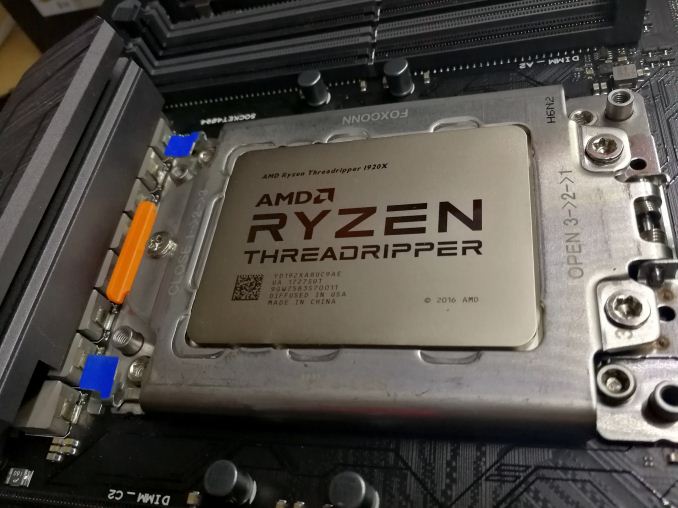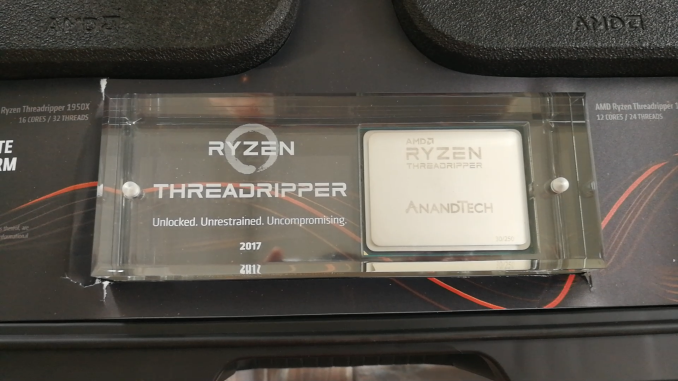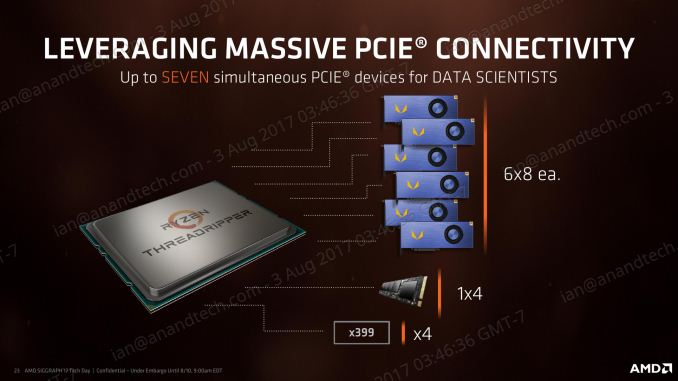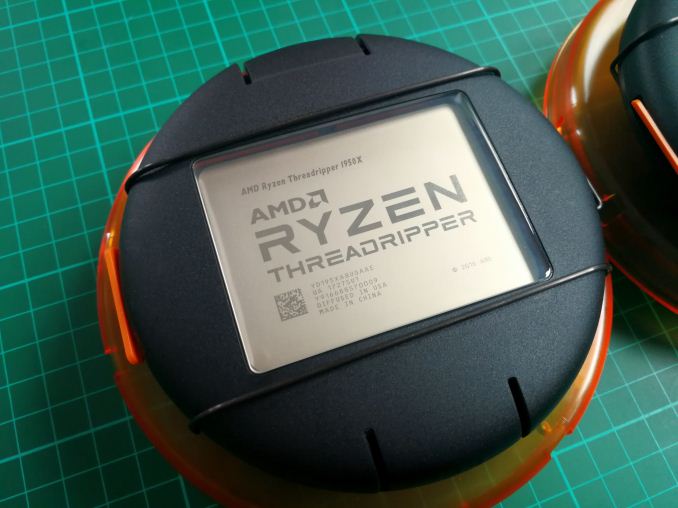The AMD Ryzen Threadripper 1950X and 1920X Review: CPUs on Steroids
by Ian Cutress on August 10, 2017 9:00 AM ESTFinal Thoughts: Do or Do Not - There is no Try
In this review we’ve covered several important topics surrounding CPUs with large numbers of cores: power, frequency, and the need to feed the beast. Running a CPU is like the inverse of a diet – you need to put all the data in to get any data out. The more pi that can be fed in, the better the utilization of what you have under the hood.
AMD and Intel take different approaches to this. We have a multi-die solution compared to a monolithic solution. We have core complexes and Infinity Fabric compared to a MoDe-X based mesh. We have unified memory access compared to non-uniform memory access. Both are going hard against frequency and both are battling against power consumption. AMD supports ECC and more PCIe lanes, while Intel provides a more complete chipset and specialist AVX-512 instructions. Both are competing in the high-end prosumer and workstation markets, promoting high-throughput multi-tasking scenarios as the key to unlocking the potential of their processors.
| The Battle | |||||||||
| Cores/ Threads |
Base/ Turbo |
XFR/ TB |
L3 | DRAM 1DPC |
PCIe | TDP | Cost (8/10) |
||
| AMD | TR 1950X | 16/32 | 3.4/4.0 | +200 | 32 MB | 4x2666 | 60 | 180W | $999 |
| Intel | i9-7900X | 10/20 | 3.3/4.3 | +200 | 13.75 | 4x2666 | 44 | 140W | $980 |
| Intel | i7-6950X | 10/20 | 3.0/3.5 | +500 | 25 MB | 4x2400 | 40 | 140W | $1499 |
| AMD | TR 1920X | 12/24 | 3.5/4.0 | +200 | 32 MB | 4x2666 | 60 | 180W | $799 |
| Intel | i7-7820X | 8/16 | 3.6/4.3 | +200 | 11 MB | 4x2666 | 28 | 140W | $593 |
What most users will see on the specification sheet is this: compared to the Core i9-7900X, the AMD Ryzen Threadripper 1950X has 6 more cores, 16 more PCIe lanes, and ECC support for the same price. Compared to the upcoming sixteen core Core i9-7960X, the Threadripper 1950X still has 16 more PCIe lanes, ECC support, but is now substantially cheaper.
On the side of the 1920X, users will again see more cores, ECC support, and over double the number of PCIe lanes compared to the Core i7-7820X for $100 difference. Simply put, if there is hardware that need PCIe lanes, AMD has the solution.
In our performance benchmarks, there are multiple angles to describe the results we have collected. AMD is still behind when it comes to raw IPC, but plays competitively in frequency. Intel still wins the single threaded tasks, especially those that rely on DRAM latency. AMD pulls ahead when anything needs serious threads by a large amount, and most of the time the memory arrangement is not as much of an Achilles heel as might be portrayed. If a user has a workload that scales, AMD is bringing the cores to help it scale as wide as possible.
Despite Threadripper's design arguably being better tuned to highly threaded workstation-like workloads, the fact that it still has high clocks compared to Ryzen 7 means that gaming is going to be a big part of the equation too. In its default Creative Mode, Threadripper’s gaming performance is middling at best: very few games can use all those threads and the variable DRAM latency means that the cores are sometimes metaphorically tripping over themselves trying to talk to each other and predict when work will be done. To solve this, AMD is offering Game Mode, which cuts the number of cores and focuses memory allocations to the DRAM nearest to the core (at the expense of peak DRAM bandwidth). This has the biggest effect on minimum frame rates rather than average frame rates, and affects 1080p more than 4K, which is perhaps the opposite end of the spectrum to what a top-level enthusiast would be gaming on. In some games, Game Mode makes no difference, while in others it can open up new possibilities. We have a full article on Game Mode here.
If I were to turn around and say that Threadripper CPUs were not pure gaming CPUs, it would annoy a fair lick of the tech audience. The data is there – it’s not the best gaming CPU. But AMD would spin it like this: it allows the user to game, to stream, to watch and to process all at the same time.
You need a lot to do in order to fill 16 cores to the max, and for those that do, it’s a potential winner. For anyone that needs hardcore throughput such as transcode, decode, rendering such as Blender, Cinema 4D or ray-tracing, it’s a great CPU to have. For multi-GPUs or multi-storage aficionados or the part of the crowd that wants to cram a bunch of six PCIe 3.0 x8 FPGAs into a system, AMD has you covered.
Otherwise, as awesome as having 16 cores in a consumer processor is – and for that matter as awesome as the whole Threadripper name is in a 90s hardcore technology kind of way – Threadripper's threads are something of a mixed blessing in consumer workloads. A few well-known workloads can fully saturate the chip – video encoding being the best example – and a number of others can't meaningfully get above a few threads. Some of this has been due to the fact that for the last 8 years, the bread-and-butter of high-end consumer processors have been Intel's quad-core chips. But more than that, pesky Amdahl's Law is never too far away as core counts increase.
The wildcard factor here – and perhaps the area where AMD is treading the most new ground – is in the non-uniform allocation of the cores. NUMA has never been a consumer concern until now, so AMD gets to face the teething issues of that introduction head on. Having multiple modes is a very smart choice, especially since there's a good bit of software out there that isn't fully NUMA-aware, but can fill the CPU if NUMA is taken out of the equation and the CPU is treated as a truly monolithic device. Less enjoyable however is the fact that switching modes requires a reboot; you can have your cake and eat it too thanks to mode switching, but it's a very high friction activity. In the long-term, NUMA-aware code would negate the need for local vs distributed if the code would pin to the lowest latency memory automatically. But in lieu of that, AMD has created the next best thing, as even in an ideal world NUMA is not without its programming challenges, and consequently it's unlikely that every program in the future will pin its own memory correctly.
In that respect, a NUMA-style CPU is currently a bit of a liability in the consumer space, as it's very good for certain extreme workloads but not as well balanced as a single Ryzen. Costs aside, this means that Threadripper isn't always a meaningful performance upgrade over Ryzen. And this isn't a catch unique to AMD – for the longest time, Intel's HEDT products have required choosing between core counts and top-tier single-threaded performance – but the product calculus has become even more complex with Threadripper. There are trade-offs to scaling a CPU to so many cores, and Threadripper bears those costs. So for the consumer market its primarily aimed at, it's more important than ever to consider your planned workloads. Do you need faster Handbrake encoding or smoother gameplay? Can you throw enough cores at Threadripper to keep the beast occupied, or do you only occasionally need more than Ryzen 7's existing 8 cores?
AMD has promised that the socket will live for at least two generations, so Threadripper 2000-series when it comes along should drop straight in after a BIOS update. What makes it interesting is that with the size of the socket and the silicon configuration, AMD could easily make those two ‘dead’ silicon packages into ‘real’ silicon packages, and offer 32 cores. (Although those extra cores would always be polling at far memory speeds).
This is the Core Wars. A point goes to the first chip that calculate the Kessel run in under twelve parsecs.














347 Comments
View All Comments
Pekish79 - Friday, August 11, 2017 - link
Vraybench 1.0.5SanX - Friday, August 11, 2017 - link
*** AMD, make 2-chip mobos for upcoming multicore wars, you will double your profit from this at no cost for you +++vicbee - Friday, August 11, 2017 - link
Off subject: Having just read the article about nVidia's meteoric rise in profits, some of which directly attributed to high end "gamers" video cards purchased expressly for coin mining, I wonder if it and AMD are going to manufacture CPU's and GPU's specifically for that purpose and how that will affect the price of said parts...Avro Arrow - Friday, August 11, 2017 - link
Hi Ian, thanks for doing this article. It's important to see all possible outcomes because in the real world, anything is possible. I do have one question that has be puzzled. Why do you say that Threadripper only has 64 PCI-Express 3.0 lanes when it's been reported several times by everyone, including official AMD releases (and also including by you) that it has 64? I thought it might be just a typo but you state it in several places and in all of your specs. This is not a new thing so is there something about Threadripper that we don't know?HotJob - Friday, August 11, 2017 - link
Could someone explain to me what a "2P" system is from the competition section of the article?coolhardware - Saturday, August 12, 2017 - link
"2P" system = two processor system, i.e. a system with two physical CPU sockets and two CPUs installed.In the past a 2P (or 4P) system was really handy to get more cores especially back when 1 core, 2 core, and eventually 4 core CPUs were high end. In the consumer realm, way back, the Pentium II was the first 2P system I ever built and people even did it with Celerons as well:
http://www.cpu-central.com/dualceleron/
the Opterons were also fun for dual or quad processor systems including some SFF options like the ZMAX-DP socket 940 system.
https://www.newegg.com/Product/Product.aspx?Item=N...
Now fast forward with ThreadRipper already available at Amazon and NewEgg
http://amzn.to/2wDqgWw (URL shortened)
https://www.newegg.com/Product/Product.aspx?Item=N...
I do not think I will ever be building a 2P or 4P system again!!!
:-)
rvborgh - Friday, August 11, 2017 - link
hi Ian,i think the Cinebench 11.5 benchmarks are incorrect for both ThreadRippers. ThreadRipper is almost equivalent to my Quad Opteron (48 core) system which scores 3229cb on R15... and 39.04 on Cinebench 11.5. if i downclock all cores to approximately 2.9 GHz i end up with around 3000cb in R15 and in the 36 range point range for 11.5.
The fact that you are only scoring in the 18 range makes me wonder if you had the Threadripper set in some mode where it was only using 8 out of the 16 cores. Can you verify this... please? Thanks :) i would think you should see scores in the 36 range with 11.5.
Other than this minor detail... great article.
PS: i've had the same issues with software not liking NUMA on my quad opteron system as well... Cinebench especially does not like it.
Tchamber - Saturday, August 12, 2017 - link
Hi, Ian. Thanks for the review. As usual it was in depth and informative. I'm in the middle of building a 1700x system now based on your review. I wanted to say you handle all the nay-Sayers, gloomy Gusses and negative Nacies with aplomb! I think most people's own slant colors how they see your reviews. I appreciate the consistency of what you do here. I took a look over at Ars, and they could be called AMD shills for all the positive things they say... Keep it up!Tchamber - Saturday, August 12, 2017 - link
P.S.I loved your Kessel Run reference, it tied in nicely with your Yoda quote.
B3an - Saturday, August 12, 2017 - link
Too many plebs complaining about a lack of 3D rendering benches. The fact is a 16 core CPU is still much slower than GPU's at rendering. I'll be getting a 1950X but it wont even be used for rendering when i know for a fact that my two GPUs will still be much faster with things like Blender. Even a single high-end GPU will still easily beat the 1950X at these tasks.Seems like immature moron fanboys are crying over this stuff because they just want to see AMD at the top of the charts.